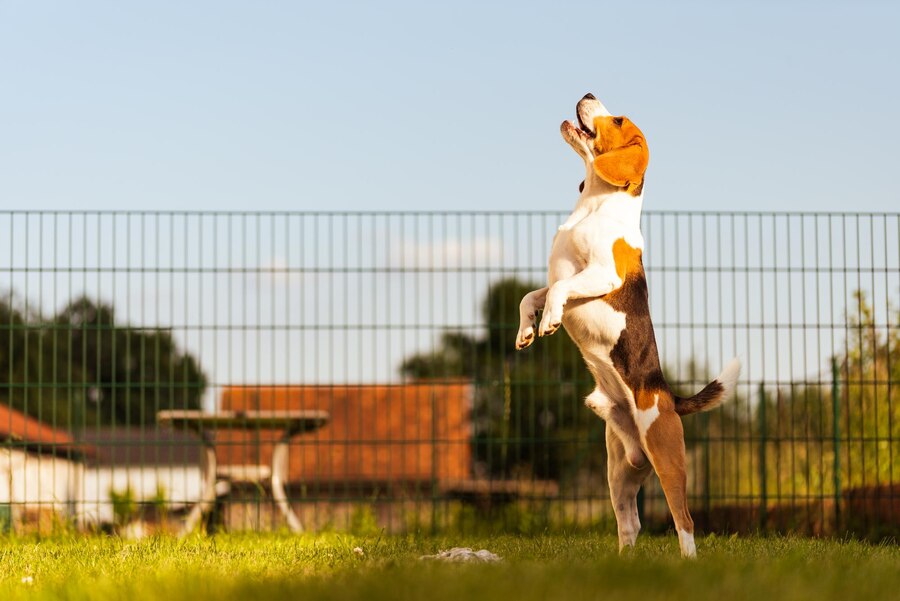To keep a dog from jumping a fence, increase fence height and provide mental stimulation. Use deterrents like coyote rollers or lean-in extensions.
Dogs often jump fences due to boredom, anxiety, or a strong prey drive. By addressing the root cause, you can prevent this behavior. Increasing the height of your fence makes it more challenging for your dog to jump over. Installing coyote rollers or lean-in extensions can also deter them.
Providing ample mental and physical stimulation helps keep your dog engaged and reduces the desire to escape. Regular exercise, interactive toys, and training sessions can significantly improve their behavior. Always supervise your dog when outside to ensure their safety and well-being.
Common Reasons For Fence Jumping
Dogs love to explore. They are naturally curious. A dog might see something interesting. It could be another animal. It could be a person or an object. Dogs want to investigate. They jump the fence to get closer. Keep your dog entertained. Provide toys and activities. This helps reduce curiosity about the outside world.
Fear can drive a dog to jump. Loud noises can scare them. Thunderstorms or fireworks are common triggers. Anxiety can also be a factor. Separation anxiety is common in dogs. They might jump to find their owner. Comfort your dog during stressful times. Safe spaces can help reduce anxiety. Training can also help manage these behaviors.
Choosing The Right Fence
Selecting the right fence is crucial to prevent a dog from jumping over. Ensure the fence height is sufficient and consider adding coyote rollers to deter climbing.
Height And Material
A tall fence is essential for keeping your dog inside. Most dogs can jump over short fences easily. A fence at least six feet high is ideal. The material of the fence is also important. Sturdy materials like wood or metal work best. These materials are hard for dogs to break or climb. Avoid fences with gaps. Dogs can squeeze through them. Chain-link fences are not recommended. Dogs can climb them.
Secure Foundations
A strong foundation prevents digging. Dogs often dig under fences to escape. Bury the fence at least one foot deep. Use concrete at the base for extra security. Check for any weak spots regularly. Fix them quickly to prevent escapes. Adding a layer of rocks or bricks can also help. This makes it harder for dogs to dig. Secure foundations keep your dog safe and contained.
Training Your Dog
Prevent a dog from jumping a fence by installing higher barriers and providing ample exercise. Use deterrents like safe, non-toxic sprays or physical barriers to discourage jumping. Consistent training and supervision can reinforce boundaries and ensure your dog’s safety.
Basic Commands
Teach your dog to sit, stay, and come. These commands help control your dog. Use treats and praise as rewards. Make training fun and short. Practice daily to reinforce learning. A well-trained dog is less likely to jump.
Positive Reinforcement
Reward your dog for good behavior. Give treats when the dog stays calm. Praise your dog with kind words. Avoid punishing your dog for jumping. Positive reinforcement works better. Consistency is key in training.
Using Barriers And Deterrents
Invisible fences use electric signals to keep dogs in the yard. A collar gives a small shock when the dog gets too close to the boundary. This teaches the dog to stay within the safe area. Many dogs learn quickly and avoid the fence. These fences are easy to install and do not block the view.
A tall fence can stop dogs from jumping over. The fence should be at least 6 feet high. Another option is an angled fence. This type of fence leans inward at the top. Dogs find it hard to climb. Adding chicken wire to the top of the fence can also help. It makes the fence higher and harder to climb.
Exercise And Mental Stimulation
Daily walks can keep your dog happy and calm. A tired dog is less likely to jump fences. Walks help your dog use up energy. Short walks in the morning and evening work well. These walks can be fun and relaxing for both of you. Consistent walks build a strong bond. The more you walk, the happier your dog will be.
Interactive toys can keep your dog busy. Toys like puzzle feeders are great. They challenge your dog’s mind. These toys make your dog think and work. Your dog will focus on the toy and not the fence. Rotating toys keeps things fresh and exciting. A busy mind means a happy dog.
Creating A Dog-friendly Yard
Designate areas where your dog can play safely. Use secure fencing to keep them contained. Add toys and obstacles for mental stimulation. Make sure the area is free of dangerous items. Keep the play zone clean and well-maintained. This ensures your dog stays happy and safe.
Provide plenty of shaded areas for your dog. Use trees, awnings, or shade sails to create cool spots. Dogs need a place to rest away from direct sunlight. Ensure the shaded areas are easily accessible. Place water bowls in the shade to keep your dog hydrated. This helps prevent heat exhaustion.
Addressing Behavioral Issues
Dogs with separation anxiety often try to escape. They miss their owners too much. Try to leave some toys or clothes with your scent. This can comfort them. Also, practice leaving and coming back. Start with short periods. Gradually increase the time away. This helps them feel safe when alone.
Dogs may jump fences when they are bored. Keep them busy with toys and games. Walk them daily for exercise. Teach them new tricks to engage their minds. Play fetch or tug-of-war. Spend time with them to prevent boredom. Happy dogs are less likely to jump fences.
Professional Help
A professional dog trainer can help stop your dog from jumping fences. They use positive reinforcement to teach your dog better behavior. Trainers can also identify the reasons behind the jumping. This helps in creating a more effective training plan.
Trainers offer one-on-one sessions or group classes. These sessions provide socialization and obedience training. Investing in a trainer ensures your dog stays safe and happy at home.
A veterinarian can check for health issues causing your dog to jump fences. Sometimes, anxiety or other health problems can lead to this behavior. The vet may suggest medications or other treatments.
They can also recommend changes in diet or exercise. This helps keep your dog calm and less likely to jump. Regular check-ups ensure your dog stays healthy and happy.
Another Post: How to Keep Dog Cool in Summer Without AC
FAQ
Why Does My Dog Jump The Fence?
Dogs jump fences due to boredom, excitement, or anxiety. Providing mental and physical stimulation can help reduce this behavior.
How Can I Stop My Dog From Escaping?
Increase fence height, use coyote rollers, or install a secure enclosure. Address underlying behavioral issues through training.
What Are Safe Deterrents For Fence Jumping?
Use motion-activated sprinklers, add landscaping barriers, or create a dig-proof base. Ensure deterrents are humane and safe.
Conclusion
Keeping your dog from jumping a fence requires consistent training and preventive measures. Use deterrents like taller fences and barriers. Engage your dog with toys and activities to reduce boredom. Always supervise outdoor time and reinforce positive behavior. A secure environment ensures your dog’s safety and happiness.

